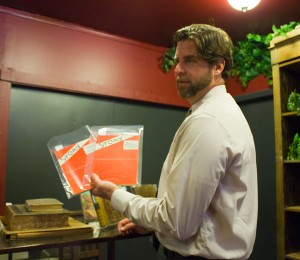Nestled in dark wood bookcases below a burgundy stripe of paint sit thousands of yellowed pages waiting for a home. But these are no ordinary paperbacks gathering dust. These are first editions, signed books and complete sets of works.

For those at National Book Auctions in Ithaca — a quick drive up Danby Road, south of Ithaca College — rare books have been elevated to the status of great artwork, something to be cherished, rather than just vessels of information.
Auction Manager David Hall said a book must have some sort of collectible factor to find a market.
“The book is dead,” he said. “It’s far outstripped as far as utility by the digital version. The good news is the collectable book is becoming more and more prized. If I were a book, I’d be pleased with that transition. You stop being a worker and become a piece of art.”
The gallery is home to an auction every three to five weeks, with an average of 400 lots for sale. The next auction is Sunday. Those lots can be a single book or a set, depending on how they were found and how rare they are. Any given auction can have upwards of 1,000 books for sale.
Hall said he began dabbling in online book sales in 1998 and, since 2004, has held auctions in the revamped motorcycle shop on Danby Road. Each auction brings in 20 to 30 people, with thousands more bidding online.
Eric Lindstrom, director of sales and marketing, was onsite to show off what appears to be just a simple brown book, carefully opening it to reveal an original page written in the loopy handwriting of the masterful Mark Twain. Inked on the glossy sheet of paper, the manuscript page is hidden in the back of “The Writings of Mark Twain” from 1929. This is the piece Lindstrom said he is most excited about.
“The book is remarkable,” he said. “This singular one page in Twain’s handwriting makes the entire set extraordinarily more valuable. I’ll be sad to see it go.”
Also up for sale in this weekend’s auction is a lot containing the complete works of Edgar Allen Poe and a first edition of the Dr. Seuss classic, “The Cat in the Hat,” with a valuable original dust jacket. Propped right below it is a first edition of Ray Bradbury’s “Fahrenheit 451,” next to two copies of the magazine J.D. Salinger was first published in.
“I really get to mine [through] history in a way that is special,” Hall said.
Lindstrom said his job mostly entails getting books from estates, but many of the best sales come from sheer happenstance. He found the Salinger magazines in a collection during the local Friends of the Library book sale, and said he hopes the fact Twain kept a summer house in Elmira will bring in more locals to the auction.
“It’s fortuitous when we find things,” he said. “We do a lot of local business, but it’s not the bulk of it. I’m hoping the local ties to the Elmira area will draw in people with the Twain.”
Other paper items, like Civil War letters and antique atlases, are also at the auction. It’s these finds that turn the gallery into a mini museum once a month.
Jack Goldman, owner of The Bookery, a used and rare books shop in the DeWitt Mall downtown, frequently attends National Book Auctions to add items to his store.
“I was told to never fall in love with the books you buy,” he said. “A rare book will rarely sell, but when the right person for that book comes along, you have to learn to part with it.”
In the back room of National Book Auctions, tucked away like a hidden map in the back of an adventure story, is the shipping and packing room, where they ship books all over the world. One man in Johannesburg, South Africa, orders something every auction.
Naturalist John James Audubon’s “Birds of America” sold for $11.5 million at auction last December. Hall said there is a significant amount of money at stake in these auctions, more than most people realize. Five or six figure books are not unheard of at auctions.
Hall said it is not uncommon to see books dating back to the 1200s, all hand produced, which still hold up well. He said one of the best parts of his job is getting to sit down and handle something that pre-dates the printing press.
“That’s one of the really special things about books — they have really good durability relative to other personal property,” he said. “They’ve survived. Trying to own a 14th century piece of porcelain is really difficult, but you could buy a 14th century book for far less.”
For Hall, pricing is sometimes the most difficult task. Often he will have something really rare and no auction records of it ever selling.
“It’s all snowflakes,” he said. “Every one of the them is something different that hasn’t happened before in some way. It’s not so much about when we sell it as when we find it. That’s the more exciting time.”
Goldman said, for him, it was all a matter of finding the right book. He said people are interested in different books in their own right.
“You can discover something you didn’t immediately come in for — a connection you didn’t know existed,” he said. “It’s more serendipitous. It’s the greatest feeling when someone doesn’t expect to find something, and then a light bulb goes on, and they fall in love with a book.”
If You Go
National Book Auction
When: 10 a.m. preview, noon auction Sunday
Where: 1429 Danby Rd.
How much: Free to preview




